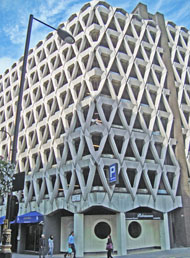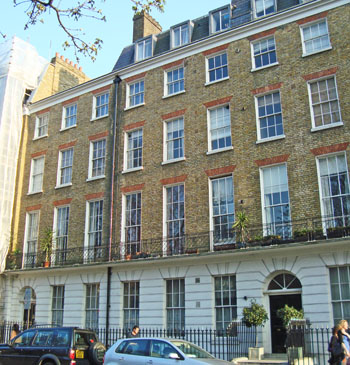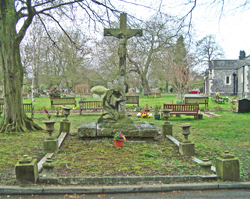Royal Flying Corps Hospital
37 Dorset Square, NW1 6QN
Medical dates:
Medical character:
Convalescent (military)
The first auxiliary hospital in
London especially for sick or wounded members of the Royal Flying
Corps was established by Dr Charles Atkin Swan (1863-1923). Dr
Atkin Swan, a distinguished amateur photographer, had been in France in
1915 acting as a photographic expert for the Royal Flying Corps.
Mrs Hugh Paynter, a former patient of Dr Atkin Swan, who had derived considerable benefit from vaccine treatment, enthusiastically helped him to establish the Hospital. She provided a considerable sum of money and collected an even larger sum from her friends and acquaintances.
In July 1915 a few beds for officers of the Royal Flying Corps in need of surgical, medical or vaccine treatment were taken at Netley House, a Nursing Home in Henrietta Street. (T.A.B. vaccine against typhoid, paratyphoid A and paratyphoid B was employed in the Royal Flying Corps at least 18 months before the other services began vaccination for the prevention of enteric fevers.)
In October 1915 a large house in Dorset Square was leased, and became the Royal Flying Corps Hospital. An operating theatre was installed and the patients were transferred from Netley House (the expenses for four months at the Nursing Home proved to be £103 10s 8d (£103.53).
The Hospital had two wards on the first floor - one with 5 beds and one with 3 beds. There was also an isolation room for patients whose condition was in doubt. The building also contained a kitchen, an Officers' Sitting Room, bathrooms and nurses' rooms, etc.
The trained head nurse and the necessary domestic staff were paid, but all other helpers were voluntary. Mrs Hugh Paynter was the Lady Superintendent. The medical staff - surgeons, physicians, specialists in nose, throat and ear surgery, ophthalmology, neurology, dermatology, dental surgery, bacteriology, radiology and anaesthesiology - all gave their services freely.
During the first three months of the Hospital's operational life, as well as the quarterly rent for the building of £81 18s (£81.90), some £124 2s (£124.10) had been spent on provisions, £74 0s 6d (£74.02) on drugs, surgical equipment and applianaces (including £6 7s 7d (£6.38) on wines!), £152 13s 6d (£152.67) on domestic needs (hardware sundries and cutlery, crockery, coals, laundry, linen, blankets, beds and bedding, linoleum, lamps, bells and electric light repairs), £58 5s 5d (£58.27) on salaries (of which £27 10s 8d (£27.53) was on nurses and £30 14s 9d (£30.74) on servants), £19 7s 7d (£19.38) on establishment charges (of which £5 8s 2d (£5.41) on postage and stationery and £13 19s 5d (£13.97) on travelling, carriage, telephone and sundries) - a total of £510 7s 0d (£510.35).
Brigadier-General The Rt. Hon J.E.B. Seely lent Brooke Hill, Freshwater, Isle of Wight, as a convalescent home, defraying the greater portion of expenses himself.
While the Hospital had sufficient income, as the rate of casualties within the Royal Flying Corps greatly increased, so did the need for larger premises with 15-16 beds.
In April 1916 Lady Tredegar offered her home in Bryanston Square for use as an auxiliary hospital, and another Royal Flying Corps Hospital opened there in May 1916.
The Dorset Square premises remained the Headquarters of the Royal Flying Corps Hospital and closed in 1919.
Present status (March 2012)
No. 37 has been combined with No. 38 to make an apartment block with 8 apartments with a shared street entrance.
Mrs Hugh Paynter, a former patient of Dr Atkin Swan, who had derived considerable benefit from vaccine treatment, enthusiastically helped him to establish the Hospital. She provided a considerable sum of money and collected an even larger sum from her friends and acquaintances.
In July 1915 a few beds for officers of the Royal Flying Corps in need of surgical, medical or vaccine treatment were taken at Netley House, a Nursing Home in Henrietta Street. (T.A.B. vaccine against typhoid, paratyphoid A and paratyphoid B was employed in the Royal Flying Corps at least 18 months before the other services began vaccination for the prevention of enteric fevers.)
In October 1915 a large house in Dorset Square was leased, and became the Royal Flying Corps Hospital. An operating theatre was installed and the patients were transferred from Netley House (the expenses for four months at the Nursing Home proved to be £103 10s 8d (£103.53).
The Hospital had two wards on the first floor - one with 5 beds and one with 3 beds. There was also an isolation room for patients whose condition was in doubt. The building also contained a kitchen, an Officers' Sitting Room, bathrooms and nurses' rooms, etc.
The trained head nurse and the necessary domestic staff were paid, but all other helpers were voluntary. Mrs Hugh Paynter was the Lady Superintendent. The medical staff - surgeons, physicians, specialists in nose, throat and ear surgery, ophthalmology, neurology, dermatology, dental surgery, bacteriology, radiology and anaesthesiology - all gave their services freely.
During the first three months of the Hospital's operational life, as well as the quarterly rent for the building of £81 18s (£81.90), some £124 2s (£124.10) had been spent on provisions, £74 0s 6d (£74.02) on drugs, surgical equipment and applianaces (including £6 7s 7d (£6.38) on wines!), £152 13s 6d (£152.67) on domestic needs (hardware sundries and cutlery, crockery, coals, laundry, linen, blankets, beds and bedding, linoleum, lamps, bells and electric light repairs), £58 5s 5d (£58.27) on salaries (of which £27 10s 8d (£27.53) was on nurses and £30 14s 9d (£30.74) on servants), £19 7s 7d (£19.38) on establishment charges (of which £5 8s 2d (£5.41) on postage and stationery and £13 19s 5d (£13.97) on travelling, carriage, telephone and sundries) - a total of £510 7s 0d (£510.35).
Brigadier-General The Rt. Hon J.E.B. Seely lent Brooke Hill, Freshwater, Isle of Wight, as a convalescent home, defraying the greater portion of expenses himself.
While the Hospital had sufficient income, as the rate of casualties within the Royal Flying Corps greatly increased, so did the need for larger premises with 15-16 beds.
In April 1916 Lady Tredegar offered her home in Bryanston Square for use as an auxiliary hospital, and another Royal Flying Corps Hospital opened there in May 1916.
The Dorset Square premises remained the Headquarters of the Royal Flying Corps Hospital and closed in 1919.
Present status (March 2012)
No. 37 has been combined with No. 38 to make an apartment block with 8 apartments with a shared street entrance.

The site of Netley House Nursing Home at No. 15 Henrietta Street now contains a restaurant with a multi-storey car park above.

No. 37 (on the right) has been combined with No. 38 (on the left) with a common street entrance at No. 38.
Dr
Atkin Swan devoted his medical knowledge to the Royal Flying Corps and,
in all established eight Royal Flying Corps Hospitals for which he acted
as administrative officer. He received the O.B.E. for these
services.
He died in 1923 at the age of 60 years.

His tomb in Hendon Cemetery is a Grade II listed building.

The inscription is no longer entirely legible.
He died in 1923 at the age of 60 years.

His tomb in Hendon Cemetery is a Grade II listed building.

The inscription is no longer entirely legible.
(Author unstated) 1916 The Royal Flying Corps Hospital. Flight, 17th February, 141-142.
http://notes onphotographs.org
www.archive.org
Return to home page